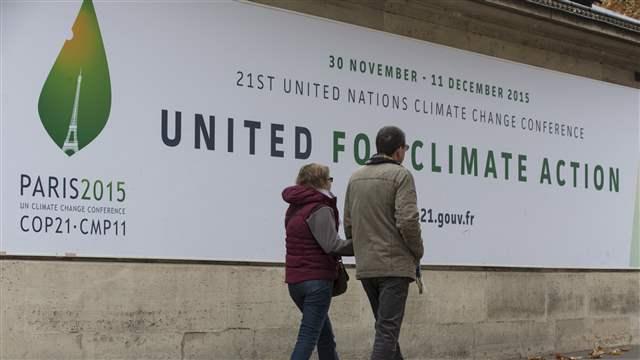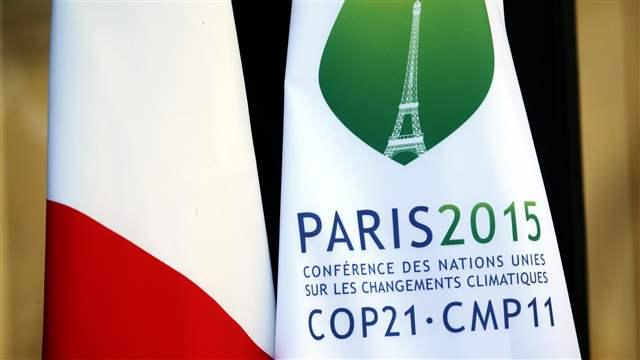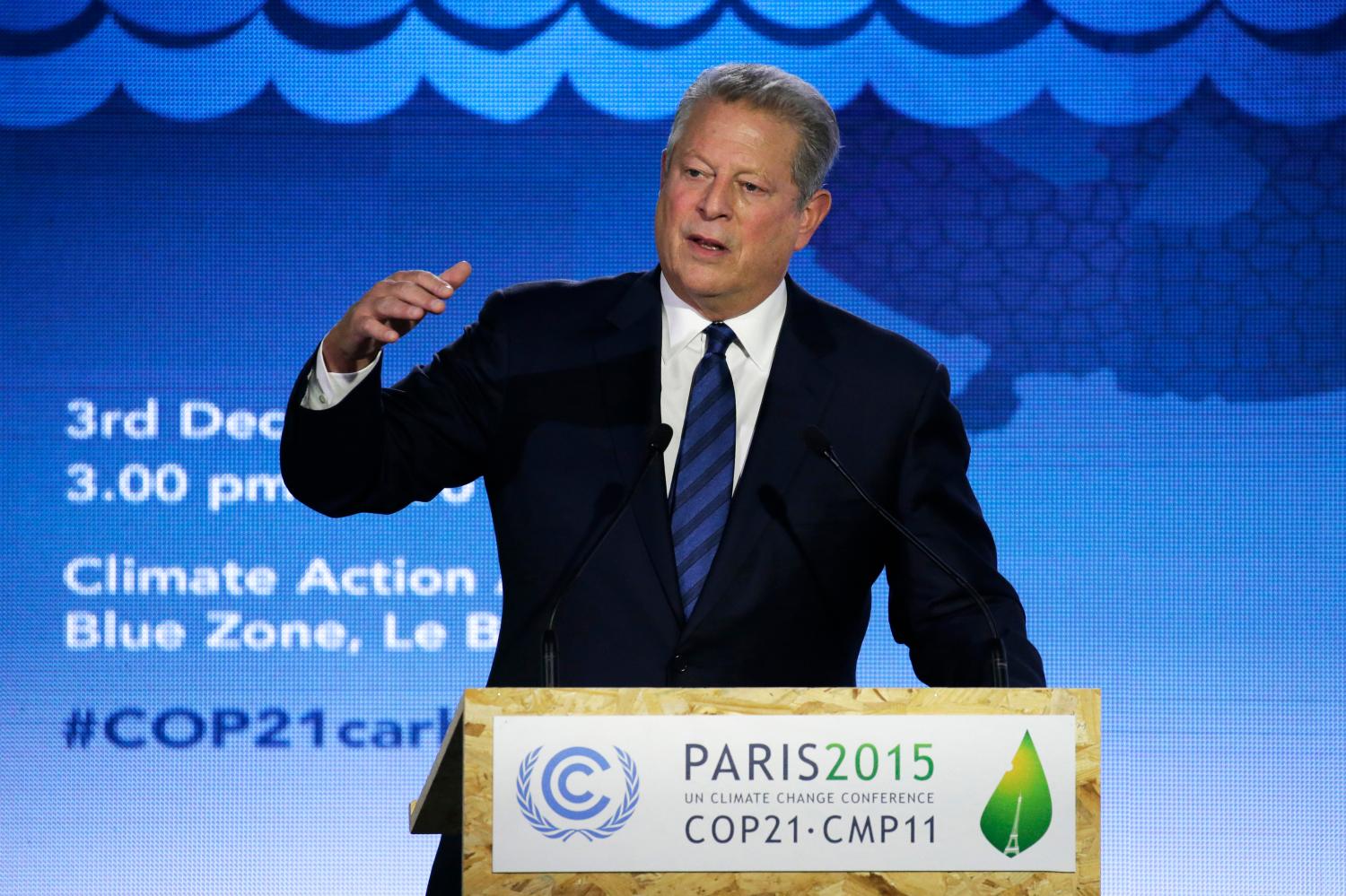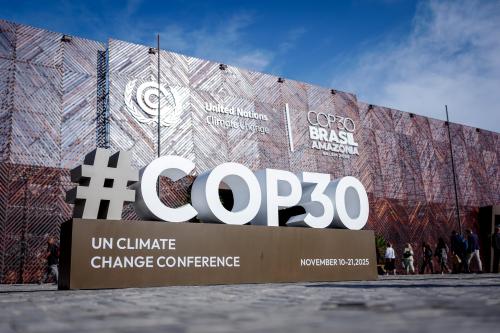In less than two weeks at the COP 21 climate conference in Paris, almost all of the world’s countries will pledge to reduce or control their own greenhouse gas (GHG) emissions. As of October 1, submissions totalling 86 percent of global greenhouse gas emissions have been made by 147 countries. These pledges, if implemented, are expected to limit the increase in emissions well below the “business as usual” forecast, though not to prevent emissions from increasing through 2030 relative to 2010.

Pedestrians walk in front of posters for the forthcoming COP21 World Climate Summit in Paris, France (REUTERS/Philippe Wojazer)
This appears to be an unprecedented success, even though much more will need to be done beyond 2030 if the world is to limit the increase in mean global temperature below 2 degrees Celsius (+2°C) relative to the pre-industrial level. Since limiting temperature change below +2°C will require reducing carbon dioxide (CO2) emissions to zero, and/or removing CO2 directly from the atmosphere, we face an unprecedented challenge.
Contributions by 49 experts to a new e-book we are a part of recognize that what we need is a regime for limiting climate change that is both workable and effective, rather than workable and insufficiently effective (as might be the case with Paris) or effective if implemented but politically unacceptable (as would be true of an “ideal,” top-down climate agreement). What follows is a summary of the takeaways in each chapter.
The Paris approaches: Top-down and bottom-up
As shown by the failure of the Kyoto Protocol, a top-down approach to the “carbon budget” implied by a successful climate regime cannot be implemented directly in a world in which states are sovereign. In contrast, the bottom-up approach adopted for the COP21 Paris climate conference under the Intended Nationally Determined Contributions (INDCs) starts with the fact that states are likely to act advance their self-interests unless they are given incentives to limit their emissions further for the sake of their collective interests. The challenge in this case is to provide these incentives. The process of assessment and review negotiated for Paris is one way to provide such incentives—by creating opportunities for “naming and shaming.”
The Paris approach is thus a blend of the top-down and bottom-up approaches, simultaneously pushing countries away from the non-cooperative outcome and pulling them toward the full cooperative outcome. However, the gap between these two outcomes is vast and will be difficult to close. The non-cooperative outcome, being grounded in self-interest, holds a strong attraction. By contrast, the ideal outcome requires deep cooperation beyond the reach of our existing institutions, requiring a new climate regime complex.

A COP21 summit flag is seen during the “France is committed to climate. Go COP21 !” event at the Elysee Palace in Paris, France (REUTERS/Charles Platiau)
The contributions in this volume show that what we need is a regime for limiting climate change that is both workable and effective, rather than workable and insufficiently effective (as might be the case with Paris) or effective if implemented but politically unacceptable (as would be true of an “ideal,” top-down climate agreement). The contributions, collected in seven parts, look to Paris and beyond, identifying the paths that the evolving climate regime can and should take. Together, they present a comprehensive set of analyses, ideas, and proposals for how to design, build, and sustain such a workable and effective regime.
Below we provide an overview of these contributions.
I. The challenge. The volume begins with a state-of-the-art assessment of the scientific, economic, and policy aspects of climate change. The purpose is to explain what is at stake in Paris and beyond. Thomas Stocker, co-chair of the Intergovernmental Panel on Climate Change (IPCC) Working Group I, distills what we have learned from the scientific assessments carried out by the Intergovernmental Panel on Climate Change (IPCC). This lucid and compact summary is complemented by an analysis of the risks and costs of alternative policies by Ottmar Edenhofer, former co-chair of the IPCC Working Group III, and his collaborators. As both contributions make clear, any further delay in mitigation action substantially increases the costs of decarbonizing our economies so as to limit mean global temperature change to 2°C relative to the pre-industrial level. It also narrows the options for this transformation, thus calling for an even wider adoption of CO2 removal technologies in the future.
What we need is a regime for limiting climate change that is both workable and effective, rather than workable and insufficiently effective (as might be the case with Paris) or effective if implemented but politically unacceptable.
Many complex and contentious issues have hampered the negotiation process leading up to Paris and will undoubtedly carry over to future negotiations. Brian Flannery reviews these issues and they are discussed further in individual chapters. Perhaps the most important of all of these issues remains the question of how the principle of “common but differentiated responsibilities” will manifest itself throughout the agreement, from mitigation to reporting and from review to finance.
II. Views from the regions. The perspectives of Africa (by Alemu Mekonnen), China (Teng Fei), India (E. Somanathan), Japan (Mitsutsune Yamaguchi and Keigo Akimoto), the EU (Roger Guesnerie), and the U.S. (Matthew Kotchen) show that perceptions about the relevance of historical emissions to future obligations vary greatly across regions and countries. So do the political processes leading to countries’ negotiating positions. These differences in perceptions contribute greatly to the difficulty in reaching an agreement among sovereign states.
III. Architecture and governance. Should an agreement to limit emissions be legally binding? Daniel Bodansky explains that there is no clear evidence that a legally binding agreement has more of an effect on state behavior than a non-legally binding agreement. Probably more important than the legally binding nature of an agreement are its precise terms, particularly with regard to the agreement’s ability to enforce participation.
Another issue is the distribution of mitigation efforts: are similar countries making similar pledges? Joseph Aldy and William Pizer find that this is a difficult question to answer, because the INDCs are expressed in different ways and no single metric exists for effort; and they conclude that comparability of pledges should be based on multiple data sources and analyses by a set of independent experts.
A third governance issue relates to whether countries’ actual behavior matches their pledges. Jonathan Wiener notes that states may be more likely to meet their pledges if their actions can be observed. Indeed, Wiener argues that monitoring, reporting, and verification (MRV) should progressively extend beyond emission levels and related outputs, to include policies and measures for reducing emissions, investment in technology research and development, financing, adaptation, and geoengineering.
Building an effective and workable climate regime will have to extend beyond the United Nations Framework Convention on Climate Change (UNFCCC) process. David Victor and Robert Keohane write that, starting from the likely Paris Agreement, momentum in negotiations could build up through what they call “experimental governance,” requiring, first, that goals be related to actions; second, that participants face significant costs when they fail to act; and third, that connections be made between various national pledges and the overall goal.
In a similar vein, Richard Stewart, Bryce Rudyk, and Michael Oppenheimer suggest that states and other actors—including firms, nongovernmental organizations, international organizations, and subnational authorities—can pursue a “building block strategy” that relies on clubs, institutional linkages, and dominant market actors. These efforts would not undermine the UNFCCC approach, but would complement it by pursuing related approaches.
Building an effective and workable climate regime will have to extend beyond the United Nations Framework Convention on Climate Change (UNFCCC) process.
An open world trading system will also be needed as competitiveness tensions increase. Petros Mavroidis and Jaime de Melo review reforms of the World Trade Organization needed to cover the labelling of energy-efficient technologies and limit the use of fossil fuel subsidies.
IV. Policy options. Papers in this section analyze various policy approaches for implementing the INDCs and undertaking further abatement efforts, with particular emphasis on carbon pricing. Dallas Burtraw discusses the regulatory approach followed by the U.S., arguing that the flexibility of the Obama administration’s Clean Power Plan mirrors the one that is under discussion in the international negotiations and that it may allow a cost-effective outcome to be brought about “through the back door.”
Against the backdrop of Sweden’s successful climate policy, Thomas Sterner and Gunnar Köhlin evaluate the feasibility of four variations to direct carbon pricing: (1) the removal of fossil fuel subsidies; (2) fuel taxation; (3) cap and trade, and direct regulation; and (4) the promotion of renewable energy, as has been done by Germany over the last 15 years. They conclude that the negotiation process in Paris might want to include many instruments for different parts of the climate change complex, possibly using a price floor to complement the quantitative commitments made so far.
The hybrid architecture that will emerge from the Paris negotiations will include bottom-up (INDCs) and top-down (MRV) elements. Instruments will differ across jurisdictions. Robert Stavins discusses the pros and cons of diverse forms of linkages across jurisdictions (e.g., acceptance of allowance or credits in another jurisdiction or crediting for compliance) that are required for this architecture to be effective. If linkage across different carbon jurisdictions has a sufficiently important role in the agreement and if operating rules are not too strict, mitigation costs would be reduced, which, in turn would encourage greater ambition later on. Leakage (i.e., the increase in foreign emissions that result from domestic actions) will be a real concern, however, as the price of fossil fuels will differ across countries. In her chapter, Carolyn Fischer considers a number of options to limit leakage and recommends a coordinated—perhaps multilateral—approach to anti-leakage measures.
V. Technology options. Stabilizing GHG concentrations requires progressively reducing emissions to zero, and/or offsetting positive emissions with an equivalent removal of CO2 directly from the atmosphere. These are the only possibilities. There is scope for reducing emissions with existing technologies, but new technologies will be needed to close the gap between the cost of fossil fuels and alternative energy sources as the scale of effort increases over time. Adoption of carbon pricing will help, but Michael Toman argues that research and development funding many times greater than current levels will be needed. This is a gap that the current round of negotiations is not seeking to bridge—at least not directly.
Cooperation must therefore occur in multiple areas simultaneously—for reducing emissions, for undertaking research and development, and for financing investment and development.
Emissions can be reduced through energy conservation and the substitution of nuclear power for fossil fuels, but these approaches are limited for various reasons. Attention has tended to focus on renewable energy. Valentina Bosetti explains why this must change in the future if emissions are to be reduced substantially. In recent years, solar and wind energy have grown enormously, but this growth is starting from a very small base. If the world is to have a chance of limiting climate change to +2°C, renewable energy will need to be scaled up to a much higher level.
In addition, CO2 will need to be removed from the atmosphere. One option for doing this involves using biomass—a renewable form of energy—to produce electricity, and then capturing and storing the carbon released in the process of combustion. The problem here is the unknowns relating to the development of systems at scale.
Carbon capture and storage is another option with high advantages like reducing leakage-related issues, but as Massimo Tavoni discusses by, this technology faces other hurdles, including the economic and social costs of storage. Carbon and solar geoengineering are two other options. As Scott Barrett and Juan Moreno-Cruz discuss, these options also face hurdles: Carbon geoengineering, which involves removing CO2 directly from the atmosphere, may be very costly. Yet solar geoengineering, which involves injecting particles into the atmosphere to reflect sunlight, is very cheap but faces governance problems and does not limit acidification of oceans.
VI. Development and non-financial aspects of burden sharing. The poorest countries have been the most severely hit by climate shocks so far, and are projected to be the most vulnerable in the future, partly because they are situated in the hottest regions. To achieve low-carbon resilient development, Stephane Hallegatte and co-authors urge long-term planning for investment, especially in urban areas, improved access to health care, and the adoption of well-targeted social safety nets.
Taking the perspective of low-income countries, Alice Akinyi Kaudia argues that submissions by low-income countries should be voluntary and contingent on financial resources that so far have not honored the principles of fairness and equity enshrined in the UNFCCC.
Arild Angelsen explains the shortcomings of attempts at forest conservation so far and gives recommendations for forest conservation to play a central role in limiting climate change.
Globally, cities currently account for over 70 percent of global GHG emissions while supporting 54 percent of the world’s population. In the future, because of the trend toward increased urbanization, cities will become even more important. Anthony Bigio reviews the strategies that can be pursued to reduce the carbon footprint of urban growth. He notes that applying the average carbon replacement value for key construction materials of developed countries to all new urban construction expected to take place in the 21st century would require one-third of the available carbon budget for limiting climate change to +2°C. Obtaining finance and using it effectively is a big challenge for developing countries, as most urban growth momentum is expected to occur in small- and medium-sized cities where governance and institutional capacities are usually weakest.
Technology cooperation should play an important role in facilitating climate change mitigation and adaptation. Heleen de Coninck and Shikha Bhasin suggest provisions to be added to the Technology Mechanism adopted in Cancun in 2009 that would help developed countries see that it is in their self-interests to assist developing countries.

The coal-fired Castle Gate Power Plant is pictured outside Helper, Utah (REUTERS/George Frey)
Equity concerns can also be addressed by reducing the supply of coal progressively rather than by reducing demand. Shutting down coal production progressively starting in the high-income countries (the U.S., Germany, and Australia) and then moving down the ladder would require cooperation but, as Paul Collier argues by, could be more effective on equity grounds than freezing discovery and new investment.
VII. Climate finance. The economic effects of the policies proposed in earlier chapters require a “redirection” of future investments toward low-carbon options. Around $5-6 trillion per year will need to be invested in infrastructure in the world’s urban, land use, and energy systems in the next two decades. Of this amount, about $1.6 trillion will need to be invested every year in energy supply, half to meet energy demand and half to replace existing plants. Additional investments to cope with the societal transformations required to achieve the +2°C target amount to about 0.75 percent of world GDP in 2013.
By contrast, limiting climate change to +2°C by means of carbon pricing would generate revenues equal to about 2.1 percent of OECD aggregate GDP in 2013. Therefore, carbon pricing can provide the financial resources needed to address the climate change problem. Improvements in the regulatory environment will also be needed so that climate finance is extended beyond national borders (currently three-quarters of climate finance is spent in the originating country/region). Barbara Buchner and Jane Wilkinson note that, so far, the “alternative sources” of finance identified in 2009 (carbon markets and prices, taxes on transport and international financial transactions, and the green bond market) have been disappointing. Strong government leadership will be needed to steer finance toward a low-carbon future. Buchner and Wilkinson suggest steps to take in that direction at the Paris conference.
New financial tools are also needed to trigger a massive wave of low-carbon investments, as carbon prices alone cannot do the job. Recognizing that, in the absence of a benevolent lender, the high upfront costs of low-carbon projects may prevent profitable investments from being financed, Jean-Charles Hourcade recommends the creation of “climate remediation assets” based on governments’ public guarantee of an attractive return on investing in low-carbon activities.
Last, the distribution of financial resources needs to be addressed. Assuming that the split of official development assistance funds between mitigation and adaptation has been decided, Patrick Guillaumont discusses the principles that should guide the distribution of funds for adaptation and proposes an index of a country’s vulnerability to weather shocks and natural hazards resulting from changes in the climate.
The Paris climate conference and beyond
Clearly, the commitments and pledges adopted in Paris will be just the first step in a long journey. Additional emission reduction efforts will need to be implemented in the coming years, and more effective policy measures will need to be adopted, both domestically and internationally. The adoption of robust systems for measurement, reporting, and verification will facilitate compliance, but without supporting enforcement measures, countries are unlikely to achieve large emissions reductions.
What is missing is both enforcement and vision. It is not enough to agree on a temperature target. It is now urgent to agree on a societal transformation path, which, in market economies at least, can be driven only by a change in relative prices. Cooperation beyond what is likely to be agreed in Paris will be needed to meet the climate change challenge:
- Agree on a reference carbon price—to be implemented progressively and through country-specific measures—that would drive investments toward low-carbon options.
- Scale up considerably contributions to research and development , notably by the public sector whose investment in energy technologies is only a quarter of the equivalent level in the 1980s.
- Address the perception of fairness to ensure effectiveness. This will require massive investment and financial support from the higher-income to the lower-income countries, development assistance that pays off globally for the countries that contribute financially as well as for the recipient countries.

The Eiffel Tower is seen at sunset in Paris, France (REUTERS/Charles Platiau)
Cooperation must therefore occur in multiple areas simultaneously—for reducing emissions, for undertaking research and development, and for financing investment and development. The scale, breadth, and complexity of the task is unprecedented, and we have no alternative but to face this challenge directly. As discussed in the book, the arrangements adopted in Paris will need to be developed and improved upon over time.
Additional efforts will also need to be pursued—whether “building blocks,” trade restrictions, or measures of some other description. The UNFCCC process will remain central to any global effort, but it will not be the only game in town. The climate problem is too complex, too far-reaching, and too important for any one institutional arrangement to address on its own. This e-book provides some guidance on how the world can navigate the unchartered territory that lies ahead of us.
Editor’s note: Scott Barrett is Lenfest Professor of Resource Economics at Columbia University and Carlo Carraro is Professor of Economics at the University of Venice.
The authors are co-editors of Towards a Workable and Effective Climate Regime, which can be downloaded
here
.
The Brookings Institution is committed to quality, independence, and impact.
We are supported by a diverse array of funders. In line with our values and policies, each Brookings publication represents the sole views of its author(s).




Commentary
Toward a workable and effective climate regime
November 25, 2015